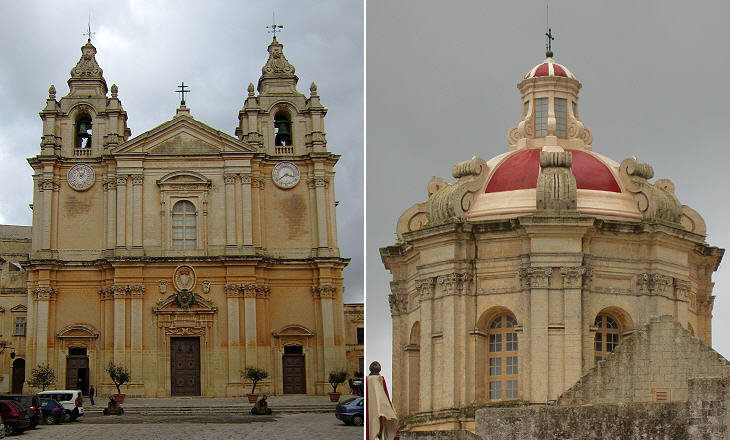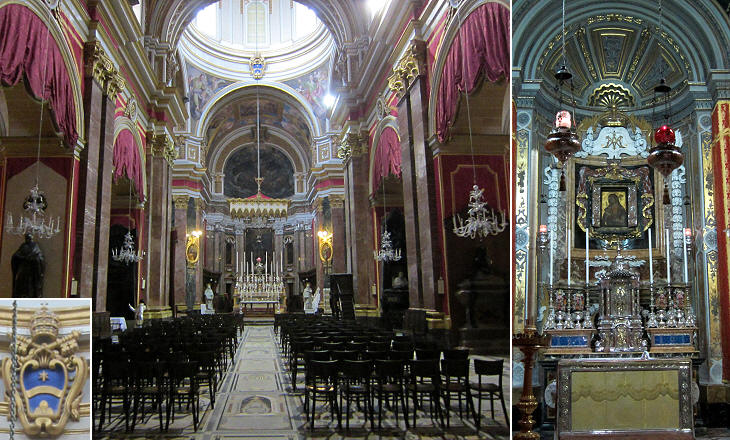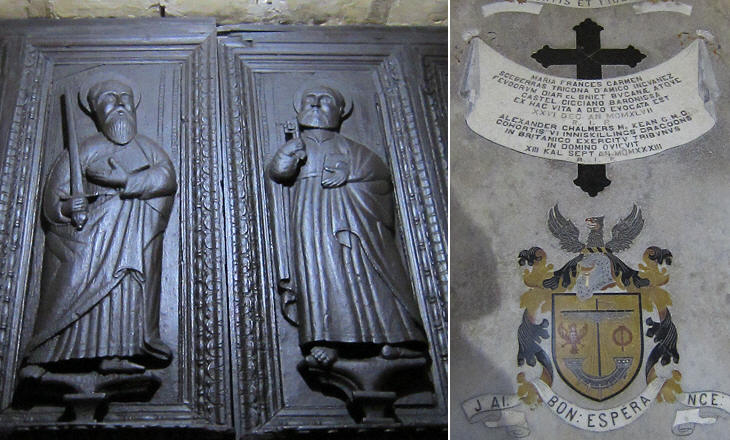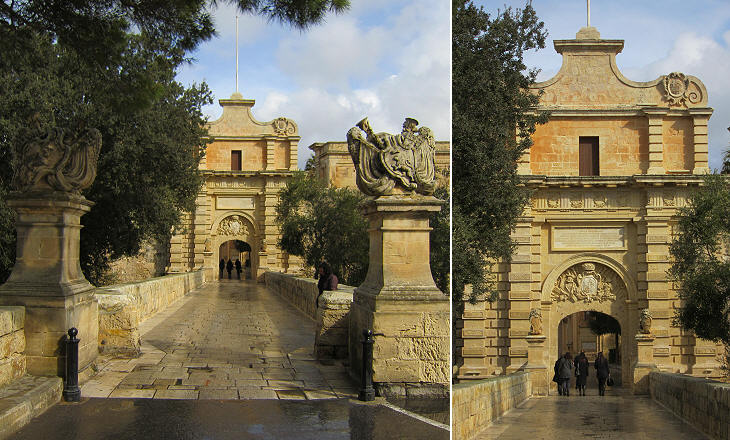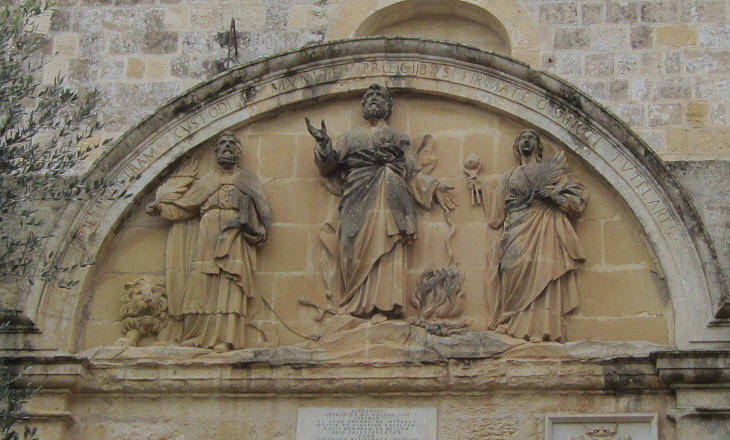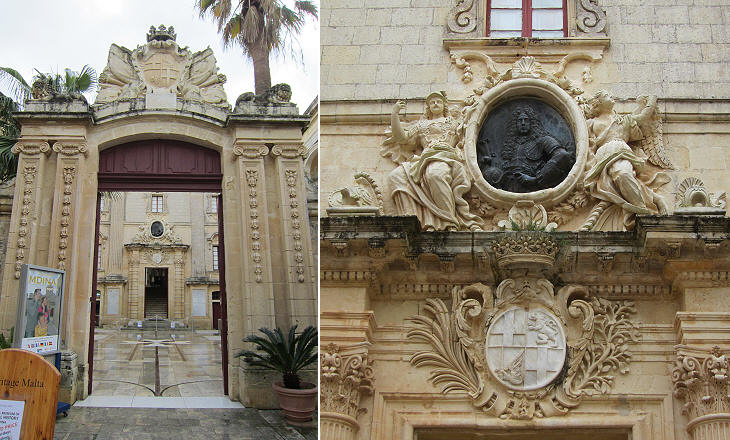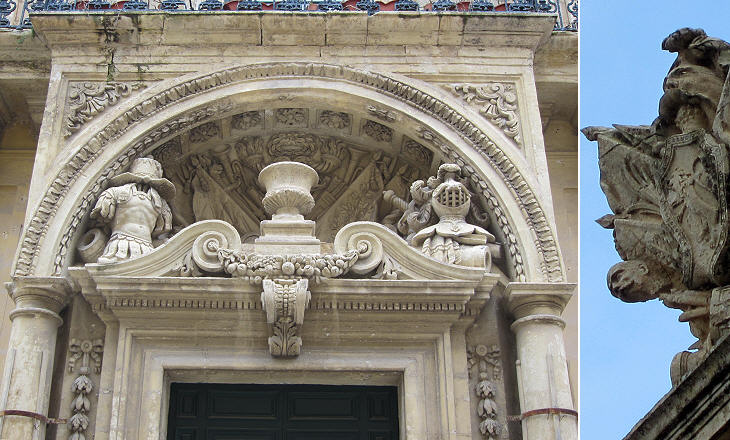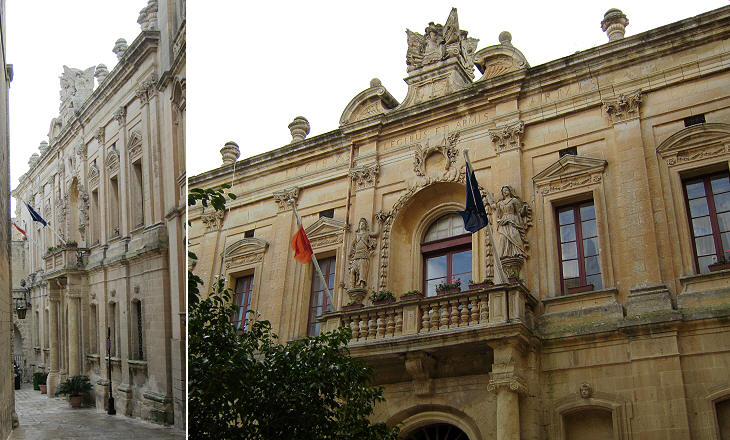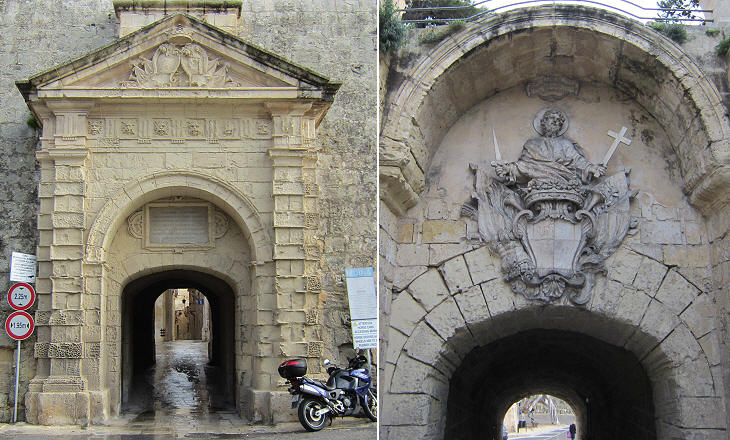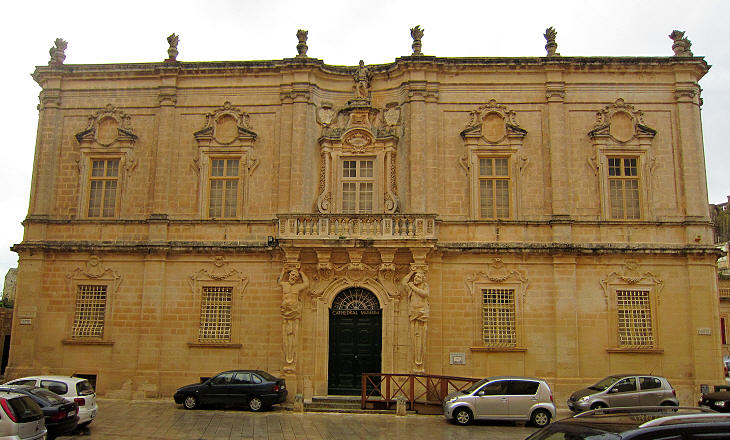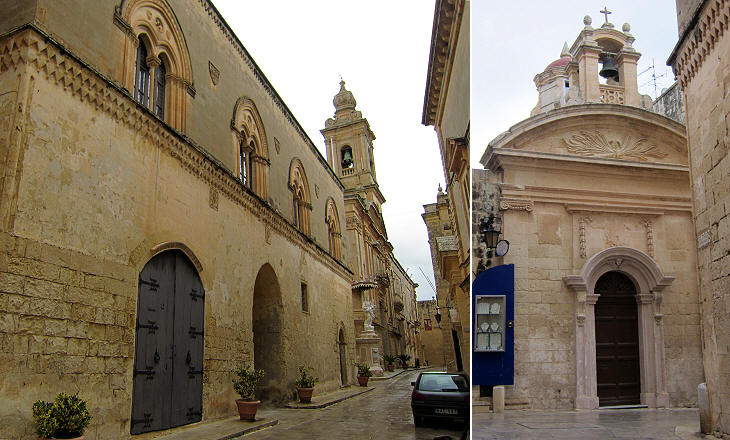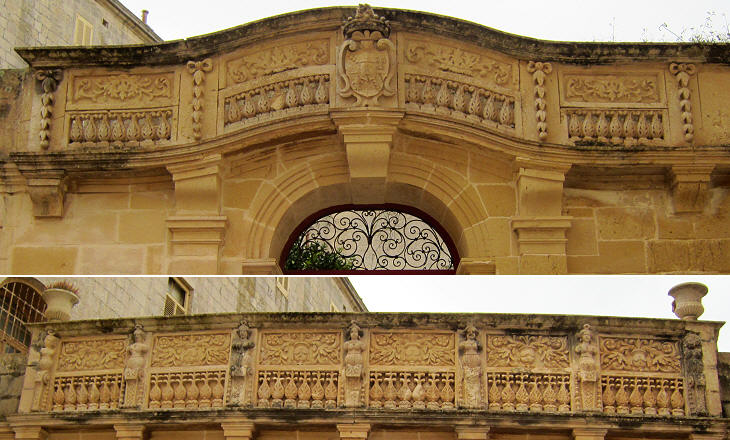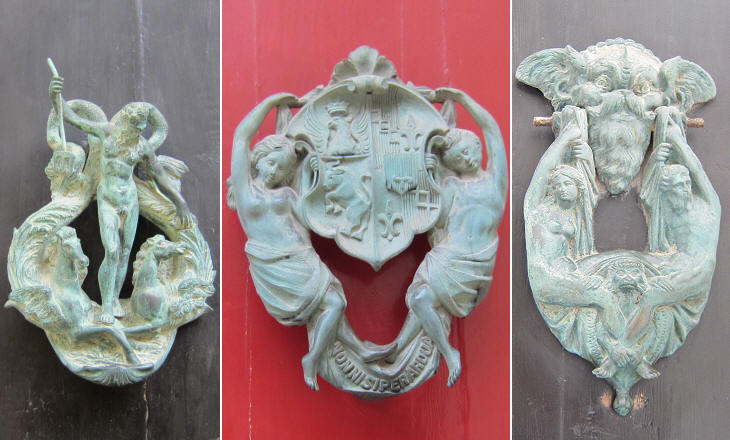  What's New! Detailed Sitemap All images © by Roberto Piperno, owner of the domain. Write to romapip@quipo.it. Text edited by Rosamie Moore. Page added in May 2012. |
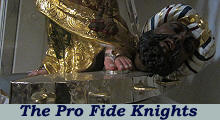 - Mdina - page two - Mdina - page two(detail of a statue of St. Catherine of the Wheel in the parish church of Zejtun) In 1693 an earthquake destroyed many buildings at Mdina, including the old cathedral.
The Cathedral of Mdina is dedicated to St. Paul whose shipwreck on the island in 60 AD is regarded as the beginning of the evangelization of Malta. Its anniversary on February 10 is a public holiday. The task of rebuilding the cathedral was entrusted to Lawrence GafÓ and it is regarded as the masterpiece of this Maltese architect, whose brother Melchiorre GafÓ (Ital. CaffÓ) was a sculptor of Gian Lorenzo Bernini's inner circle. The dome is located very near the walls of Mdina and it can be seen from almost the whole island, including Valletta, the residence of the Grand Masters.
The interior of the cathedral resembles that of a Roman church with a very rich decoration based on coloured marbles, funerary monuments and chapels with sumptuous altars. It can be considered the swansong of Italian artistic influence on Malta.
Similar to St. John's in Valletta the floor of the cathedral is covered by marble gravestones, not those of the Knights, but those of bishops and members of the local noble families. The practice was not stopped by the British administration and as a matter of fact some British officers also were buried in the church.
During the XVIth and XVIIth centuries the Grand Masters availed themselves of Italian architects or of Maltese architects who were familiar with Italian art. In the XVIIIth century they entrusted the construction of fortifications and palaces to French architects, in line with general European trends which gave France a leadership in the arts which lasted well into the XXth century. Grand Master Vilhena promoted the construction of several civilian buildings at Mdina (aka CittÓ Vecchia - Old Town) to show the presence of the Order in the religious centre of Malta. He availed himself of Charles Franšois de Mondion, a French military engineer who designed buildings and fortifications also at Floriana and Fort Manoel.
The main gate of Mdina was the site of a ceremony which followed the election of a new Grand Master; actually it was the re-enactment of the entrance of Grand Master Philippe Villiers de l'Isle Adam into Mdina in 1530 when he took possession of the town and of the island as vassal of Emperor Charles V, King of Sicily. Mondion built a large stone bridge leading to the gate which he turned into a triumphal arch to provide the ceremony with a proper setting. The inner side of the gate was decorated with a relief portraying the three patron saints of Malta so that they could attend the triumphal entrance of the new Grand Master. The ceremony was called possessio as that which occurred in Rome after the election of a new pope.
Grand Master Vilhena commissioned a palace near the main gate where he and his successors could watch the ceremonies which followed their entrance into Mdina. In the bronze medallion above the inner portal Vilhena was portrayed wearing the large wig which King Louis XIV of France made so fashionable. Probably it was very uncomfortable to wear such a wig during Malta's long and hot summer, but Vilhena wanted to convey the message that he was a sovereign on the same standing as the other European kings. As a result of the 1714 Treaty of Utrecht, Spain had lost Sicily and the Grand Masters no longer regarded themselves as vassals of the Crown of Sicily.
The Giurati were four Maltese elected magistrates who assisted the Governor of Malta before the island was assigned to the Knights. They retained a mainly honorific role which included taking part in the ceremonies associated with the "coronation" of a new Grand Master. Mondion decorated the new building where the giurati met with all sorts of military symbols, for which Grand Master Vilhena had a penchant, probably to make up for the de-facto truce between the Order and the Ottoman Empire which characterized his stay in power.
The jurisdiction of the Grand Masters often conflicted with that of the Bishops of Malta; by building the Courts of Justice in the rear part of his palace at Mdina, Vilhena wanted to emphasize the role of the Grand Masters. The fact however that an underground passage linked Corte Capitanale and its prison with Bishops' Palace indicates that religious authorities were not without a say in the administration of justice. The inscription Legibus et Armis (by using laws and arms) is a reference to the foreword of Codex Justiniani, the summary of laws issued by Emperor Justinian, who wanted to restore the Roman Empire to its former greatness by these means.
Mdina had a second gate which was redesigned by Mondion too. It is named the Greeks' Gate because some of the inhabitants of Rhodes, who in 1522 followed the Knights when they surrendered the town to the Ottomans, settled in the neighbourhood near the gate.
The building bears the coats of arms of Grand Master Vilhena and of Paolo Alpheran de Bussan, Bishop of Malta. In 1723 the previous bishop had relocated the seminary from Mdina to Valletta; the move was unwelcomed by the Knights and in 1733 it was decided to build a new seminary at Mdina, next to the cathedral. The architect is unknown; the use of telamons at the sides of the entrance was infrequent in Rome, probably owing to the availability of ancient columns, but very popular elsewhere in Europe (see some examples in Vienna).
Mdina has retained its character of religious centre of Malta although since 1814 it shares being the residence of the Bishop with Valletta. Churches and chapels are aligned along the main street which retains its old aspect with the exception of the XIXth century upper storey of Saint Sophia Palace, a Norman building.
The old noble Maltese families preferred to live in Mdina, rather than at Valletta. The Testaferrata (Ironhead) had the honour of having Fabrizio, a member of the family, appointed cardinal by Pope Pius VII in 1816. He was the first Maltese cardinal, although not the first cardinal residing on Malta, because this was Grand Master Verdale. The Maltese Testaferrata are thought to be a branch of the Capo di Ferro, who are best known for Cardinal Girolamo Capo di Ferro, the founder of Palazzo Spada in Rome.
The image used as background for this page shows a portal near Our Lady of Carmel which shows some typical Reminders of Death. Move to: Introductory Page Brief outline of the history of Malta before 1530 The Grand Masters of the XVIth century The Grand Masters of the XVIIth century The Grand Masters of the XVIIIth century Valletta: the fortifications Valletta: the churches Valletta: other monuments Borgo/CittÓ Vittoriosa (Birgu) Senglea (Isla) CittÓ Cospicua (Bormla) Floriana Other Fortifications Gozo Island Churches in the minor towns Other monuments in the minor towns Rome and Malta  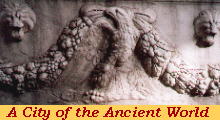 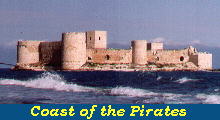 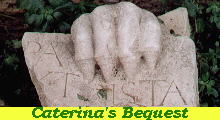 |
